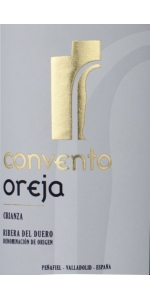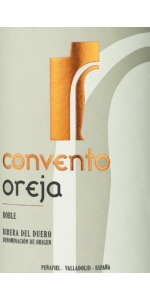Wine from Convento de Oreja

The Convento de Oreja Estate
The winery is located near the town of Peñafiel, and its name Oreja (ear) comes from the fact that Convento is located on a bend in the Duero river. This exagerated bend/oxbow is referred to as an oreja or ear shaped. Owner Antonio Vaquero lives and works in Madrid, but hails from Peñafiel, where he has been managing family vineyards. Recently, Antonio and a small group of associates decided to build their own winery, hence Convento de Oreja.
Convento de Oreja does not own winemaking facilities, but supervises the vinification in a modern facility in Peñafiel. Once the wine has been fermented/macerated, the resulting juice is barrel aged.
The Convento de Oreja Vineyard
The vines are 10-15 years old except for a small plot of 40 year old vines. The wines of Convento de Oreja are all 100% Tempranillo. Currently they own 6 hectares (14.82 acres) and manage 12 hectares more. Recently they planted 4 hectares more and all soil types are nutrient poor alluvial soils with a mix of sand and gravel. Deeper down the soil is clay and limestone, good for water retention. For now they make both Joven and Crianza style wines.
Convento Oreja Memorias Reserva is made from 100 percent 100% Tempranillo.
The wine comes from a special vineyard at 950 meters altitude. The cuvee is called MEMORIA to pay tribute to good friends and great time spent together.
Deep cherry color. On the nose, the wine is elegant and well balanced with black fruits, reminiscent of vanilla and leather. Hints of spices, minerals and coffee. On the palate the wine is also well balanced and pleasant. Round and elegant with a long and pleasing aftertaste.
Pairs well with pastas, creams and soups. Likewise, these wines are ideal for more subtle and elaborate first courses, like a rice with lobster.
Ideal for grilled red meats and stews and game stews and for the typical roast lamb.
Review:
"Deep garnet to the eye, this wine has a nose of black cherry, cocoa powder and aniseed. A sense of fruit brightness permeates the palate alongside blackberry preserve, orange zest, clove, violet and milk chocolate flavors. Lingering brightness and velvety tannins make for a gorgeous, long-lasting finish. - Mike DeSimone"
- Wine Enthusiast (June/July 2023), 94 pts
Convento Oreja Ribera del Duero Crianza is made from 100 percent Tempranillo.
Bright cherry color. On the nose you will find plenty of fruit aromas, well balanced as well as some reminiscences of spices that are appreciable. The oak presence gives elegant hints of black chocolate and vanilla. On the palate, the wine is very smooth and well balanced with the right amount of acidity. Fresh, long lasting and elegant.
The wine went through malolactic fermentation. The wine was aged 12 Months in French Oak barrels. Before bottling, the wine was slightly filtered.
Convento Oreja Ribera del Duero Crianza is made from 100 percent Tempranillo.
Bright cherry color. On the nose you will find plenty of fruit aromas, well balanced as well as some reminiscences of spices that are appreciable. The oak presence gives elegant hints of black chocolate and vanilla. On the palate, the wine is very smooth and well balanced with the right amount of acidity. Fresh, long lasting and elegant.
The wine went through malolactic fermentation. The wine was aged 12 Months in French Oak barrels. Before bottling, the wine was slightly filtered.
Review:
A bouquet of Luxardo cherry, blackberry preserves and lavender wafts from the glass. Surprisingly juicy on entry, this wine has flavors of pomegranate, ripe cherry, orange zest, dried thyme, dark chocolate and violet. Opulent tannins build in volume and then recede into a finish that is filled with bright fruit notes. — Mike DeSimone
- Wine Enthusiast (June/July 2023), 94 pts
Convento Oreja Ribera del Duero Roble is made from 100% Tempranillo
Deep black plum color with violet tones. Ripe fruit on the nose, mostly blackberries and raspberries, intermingled with hints of spice and leather. On the palate, it is warm, fresh and pleasant with a long finish.
Age of the vines: betwxeen 6 and 16 years old.
Vineyards' location: Comarca de Peñafiel.
Vinification is made in large 20,000-liter stainless steel tanks (200 hectoliters) with automated temperature control.
Fermentation lasted 5 days at 22°C temperature.
Total time for maceration lasted 9 days.
Malolactic Fermentación was completed during the month of November.
Wine was aged in French Oak barrels for a minimum of 4 months.
Review:
"Thoroughly Ribera del Duero in its power and austerity, this wine’s floral rose scents shade into blackness, lasting cleanly within a structure that’s both open and intense. There’s a hint of greenness from its time in American and French oak barrels, an edge that will tame grilled meats."
- Wine & Spirits (June 2022), 91 pts
- back
Selected Options
Wineries
Categories
Pricing
Countries
Regions
Grape Types
Wineries
Organic/Free Shipping
This is a 9 liter imperial also called a Salmanazar .
Roland Champion Champagne Blanc de Blanc Grand Cru 2014 is made from 100% Grand Cru Chardonnay from the chalky soils of Chouilly.
This Champagne is full of elegance and finesse. Very complex nose, with a bouquet of aromas dominated by honey, brioche and notes of dried fruits, hazelnuts and sweets. Perfectly matured.
Manual harvest; then pressing immediately to avoid oxidation & preserve quality. Free run juice only. Aged six years on the lees.
It matches magnificently with foie gras!
Review:
"Based in Chouilly on the Côte des Blancs, it is obvious this producer will have a Blanc de Blancs Champagne. And very good it is, with some age after six years on lees while still having freshness, crisp acidity and a tight, steely edge. The bottling will benefit from further aging, and it will be at its best from 2022. - ROGER VOSS"
- Wine Enthusiast (December 2020), 92 pt
Ghost Hull Cabernet Sauvignon is made of 100 percent Cabernet Sauvignon.
Aromas of blackberry, elderberry and ripe plum are accentuated by notes of mocha, fresh tarragon, vanilla and oak. The palate is full-bodied and offers a lovely balance of acidity and tannins accompanied by rich flavors of dark fruit and black currant, ending with a juicy and lingering finish







